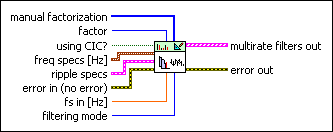Owning Palette: Multirate Filter Design VIs
Installed With: Digital Filter Design Toolkit
Creates multistage multirate filters, which meet the requirements you specify by cascading filters in multirate filters out.
Wire the multirate filters out output to the multirate filters in input of the DFD NStage MRate Filtering VI or the DFD NStage MRate Filtering for Single Block VI if you want to process data with the new filter.

 Place on the block diagram Place on the block diagram |  Find on the Functions palette Find on the Functions palette |
 | manual factorization specifies the factors for each stage. The product of all the factors in the manual factorization input must equal the factor input value. | ||||||
 | factor specifies the sampling frequency conversion factor of the multirate filter. factor must be greater than 1. The default is 8. If you set using CIC? to TRUE, factor must be greater than 4 and divisible by 4. | ||||||
 | using CIC? specifies if you want to use the cascaded integrator comb (CIC) filter design method to design one stage of the multistage multirate filters. The default is FALSE, which means this VI does not use the CIC filter design method. If the value is TRUE, this VI uses the CIC filter design method to design the first stage of the filter when you set filtering mode to Decimation, or the last stage of the filter when you set filtering mode to Interpolation. | ||||||
 | freq specs specifies the passband edge frequency and stopband edge frequency of the multistage multirate filters.
| ||||||
 | ripple specs specifies the ripple level in the passband and stopband of the filter.
| ||||||
 | error in describes error conditions that occur before this VI or function runs.
The default is no error. If an error occurred before this VI or function runs, the VI or function passes the error in value to error out. This VI or function runs normally only if no error occurred before this VI or function runs. If an error occurs while this VI or function runs, it runs normally and sets its own error status in error out. Use the Simple Error Handler or General Error Handler VIs to display the description of the error code. Use error in and error out to check errors and to specify execution order by wiring error out from one node to error in of the next node.
| ||||||
 | fs in specifies the input sampling frequency of the multistage multirate filters in hertz. The default is 800. | ||||||
 | filtering mode specifies the processing mode of the filter that this VI creates.
| ||||||
 | multirate filters out returns the new multistage multirate filters. | ||||||
 | error out contains error information. If error in indicates that an error occurred before this VI or function ran, error out contains the same error information. Otherwise, it describes the error status that this VI or function produces.
Right-click the error out front panel indicator and select Explain Error from the shortcut menu for more information about the error.
|
DFD NStage MRate Filter Design Details
Use the DFD NStage MRate Filter Design VI to create multirate filters with large multirate factors. This VI distributes a large factor into each stage of the multirate filter, as shown in the following example. A multistage design requires less computation and storage than a single-stage design.
For example, if the sampling frequency conversion factor M contains the factors M1, M2, and M3, such that M = M1*M2*M3, and M1>M2>M3>1, you can design a three-stage multirate filter in which all three stages use the same multirate processing mode that filtering mode specifies.
If you set using CIC? to TRUE, the factor M must be divisible by 4, for example, M = 2*2*M1. In this case, the filter with the largest factor M1 is a CIC filter.
The overall response of cascading the multirate filters is a lowpass response.
Examples
Refer to the following VIs for examples of using the DFD NStage MRate Filter Design VI:
- Analyze Coefficients-Quantized Multistage Multirate Filter VI: labview\examples\Digital Filter Design\Fixed-Point Filters\Multirate
- Multistage Decimation Filter Design VI: labview\examples\Digital Filter Design\Floating-Point Filters\Multirate
- Multistage Multirate Filter Design (with CIC) VI: labview\examples\Digital Filter Design\Floating-Point Filters\Multirate
- Multistage Multirate Filter Design VI: labview\examples\Digital Filter Design\Floating-Point Filters\Multirate



